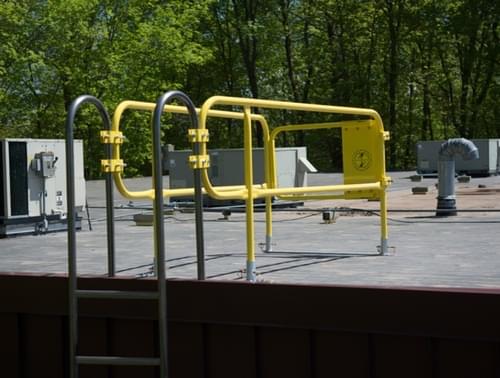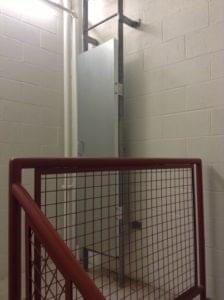There are only so many ways to access a roof, and a ladder is one of the most common. So, it's no surprise that OSHA has guardrail requirements for rooftops. But you’ll also need to consider what their guidelines are on ladder fall protection. You not only need to protect your workers when they’re up on the roof, you need to protect them on the way up and down as well.
Fortunately, it’s just a simple matter of providing the right equipment, like a ladder guard, and/or guardrail systems. But consider this: you also need to make sure your team has the appropriate ladder fall protection training. It’s easy to rest on your laurels on the idea that climbing a ladder safely is common sense. This may be true, but there are a lot of circumstances that could derail a safe climb—no pun intended. Today we’re taking a look at how you can keep your employees safe and productive when ladder usage is a part of their workload.
The first step in staying safe is know-how. By making ladder safety a part of your training program, you don’t only ensure that all your employees know ladder best practices, you also reinforce a culture of safety in the workplace at large.
OSHA has some clear rules when it comes to how employees use ladders—here are a few of them:
For more of OSHA’s ladder safety regulations, click here.
Remember, your employees should never feel awkward or undecided when faced with the decision to carry a load up a ladder. Two safe trips are always better than one overloaded trip. And in some cases it may be necessary to find another means of transporting the load to the roof.
Make it clear that you insist upon this simple but important safety measure, and employees should feel empowered to insist upon it as well. They shouldn't feel pressured by their co-workers to carry an unsafe load, for example. All employees should be aware of OSHA guardrail requirements, how to use safety equipment, and how to identify potential hazards. And that attention to safety should extend all the way to the highest levels of management.
Slipping and falling off the ladder is an obvious danger, and there are a variety of things that could contribute to a fall:
Other dangers include the risk of something falling off the roof and hitting the person on the ladder, which can cause an injury whether they fall or not. If your employees are not staying attentive, a worker could start to descend the ladder while another person is ascending, causing, at best, a cumbersome traffic jam and at worst, an accident.

There are a few rules that apply to both portable and fixed ladders. For example, the rungs must be uniformly spaced between 10 and 14 inches apart, with certain exceptions for step stools, elevator shafts, and others. Wooden ladders can’t be covered or coated with a material that would hide a potentially dangerous defect, and metal ladders must be protected against corrosion. All ladders need to be free of defects and in good working condition. And like we mentioned before, they should all be inspected before every shift.
A portable ladder must be placed on stable surfaces, and secured if it is used in a space where another activity may displace it. It can’t be moved or adjusted while someone is on it. If you're using a portable ladder to access a roof or other elevated surface, it must have rails that extend at least three feet above that surface. Take a closer look at OSHA for additional guidelines regarding portable ladders.
Fixed ladders have more considerations. There are clear regulations regarding grab bars, hatch openings (if the ladder terminates at a hatch), clearances, and more. Here are just a few of the OSHA guidelines for fixed ladders from standard 1910.23(d):
 Different types of ladders require different guardrail systems. For example, a ladder that goes up the side of the building can be used with a ladder guard at the top. This can include a safety gate that helps prevent or discourage access to the ladder. These guardrail systems are compliant with OSHA guardrail requirements and are easy to install and use. And there are more secure options available when it's necessary to prevent unauthorized access to the ladder.
Different types of ladders require different guardrail systems. For example, a ladder that goes up the side of the building can be used with a ladder guard at the top. This can include a safety gate that helps prevent or discourage access to the ladder. These guardrail systems are compliant with OSHA guardrail requirements and are easy to install and use. And there are more secure options available when it's necessary to prevent unauthorized access to the ladder.
If your ladder leads to a hatch in the roof, you need a specialized solution. This type of fall protection is adjustable to fit the size of the hatch, and the self-closing gate offers additional safety.
One more thing worth noting: requirements regarding the use of ladder cages have recently changed. All cages and wells will need to be replaced by 2036 and new ladders must be equipped with ladder safety systems or personal fall arrest systems.
Ladder fall protection may seem intuitive, but making sure your workers are safe while climbing is every bit as important as the safety precautions you take when they are working at height. If you need help developing your ladder guard strategy, give us a call. All of our products meet and exceed OSHA guardrail requirements, so you can rest assured you're using the very best equipment to protect your employees.